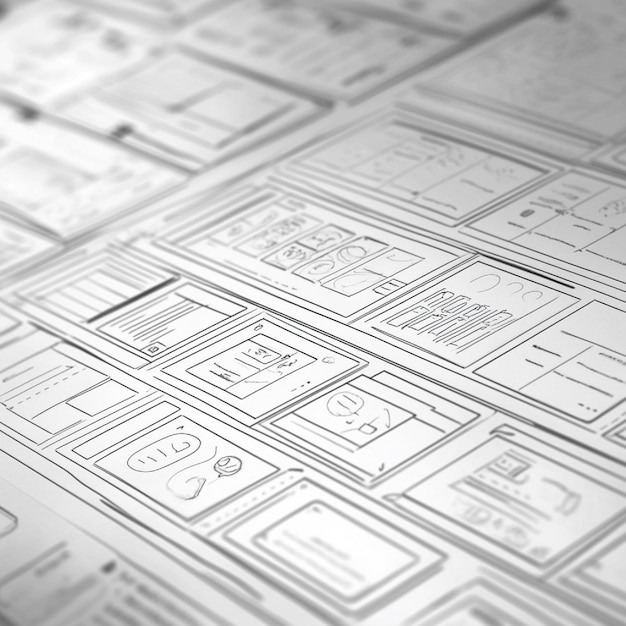
Interfaces That Respond.
Experiences That Flow.
Design interactions that guide users naturally and motion that provides clarity. Create digital experiences that feel responsive, intuitive, and alive through thoughtful interaction design.
Back to HomeWhat Great Interactions Create
Interaction design transforms static interfaces into conversations. Users receive immediate feedback to every action, understand what's happening at each moment, and move through tasks with confidence. Motion isn't decoration—it's communication that guides attention and maintains context through transitions.
Natural Understanding
Users grasp how things work without instructions. Interactive feedback shows cause and effect clearly, making interfaces feel predictable and safe to explore.
Engaged Experience
Responsive interactions keep users present and focused. Each micro-interaction acknowledges their action, building trust and encouraging continued engagement.
Smooth Transitions
Movement between states maintains spatial understanding. Users never feel lost because motion shows relationships and preserves context through changes.
Delightful Polish
Thoughtful interactions add moments of delight without distraction. Quality shines through in details that respect user attention and enhance rather than overwhelm.
When Interfaces Feel Lifeless
You've seen the symptoms. Users click buttons and wait, unsure if anything happened. Transitions feel abrupt, leaving people disoriented about where they are. Touch interactions lack the responsive feel users expect from modern interfaces. The experience feels mechanical rather than fluid, creating friction where none should exist.
Missing Feedback
Users take actions and receive no confirmation. Did the button work? Is something loading? Without feedback, uncertainty grows. People click repeatedly or abandon tasks, unsure if the interface registered their intent.
Jarring Transitions
Screens change instantly, disorienting users who lose track of where they are and how they got there. Navigation feels like teleportation rather than movement through space, creating cognitive load.
Generic Interactions
Your interface behaves like every other interface, missing opportunities to express your brand personality. Users complete tasks but remember nothing special about the experience.
Our Interaction Design Approach
We design interactions systematically, starting with core principles that align with your brand personality. Each interaction serves a purpose—providing feedback, guiding attention, or maintaining context. Motion follows physics that feels natural, never arbitrary or excessive.
Micro-Interaction Design
We craft responses to every user action—button presses, form inputs, notifications, and confirmations. Each micro-interaction provides immediate feedback, making the interface feel attentive and responsive. Users know their actions registered and understand what's happening next.
Transition Choreography
We design movement between states that preserves spatial relationships. Elements animate in ways that show where they came from and where they're going. Users maintain orientation because motion reveals structure rather than hiding it.
Gesture Design
For touch interfaces, we design gestures that feel natural and discoverable. Swipes, pinches, and drags respond with physics that matches user expectations. The interface feels like a direct manipulation of objects rather than abstract commands.
Loading and Progress
We design for waiting states that maintain engagement. Progress indicators show realistic advancement, and skeleton screens preview content structure. Users remain informed and patient because they understand what's happening.
Motion Principles
We establish guidelines for timing, easing, and choreography aligned with your brand. These principles ensure consistency across your product while allowing flexibility for different contexts. Every designer and developer works from the same motion vocabulary.
Creating Interactions Together
Interaction design happens iteratively through prototyping and refinement. We create working prototypes early so you can feel the interactions, not just imagine them. Feedback guides adjustments until every detail feels right. You're involved in key decisions about personality and behavior.
The Design Process
Interaction Audit (1 week)
We review your current product, identifying interaction patterns and opportunities. This reveals where feedback is missing, transitions are abrupt, or gestures feel unnatural. The audit creates our starting point.
Principles Workshop (1 week)
Together we establish motion principles that reflect your brand personality. Should interactions feel playful or serious? Quick or deliberate? These decisions guide all detailed design work.
Prototype Development (3-4 weeks)
We create interactive prototypes showcasing key interactions. You experience how things feel, providing feedback that shapes refinement. Iteration happens quickly at this stage when changes are inexpensive.
Specification Creation (1-2 weeks)
We document interactions with precise specifications developers need. Timing curves, durations, and choreography details ensure what gets built matches what you approved.
Implementation Support (2 weeks)
We work with your developers during implementation, ensuring interactions match specifications. Small adjustments happen as we see them in context, refining until everything feels right.
Prototype Reviews
We meet weekly to review prototypes and gather feedback. Experiencing interactions firsthand reveals what works and what needs adjustment. These sessions keep us aligned.
Design Deliverables
You receive prototypes demonstrating interactions, detailed specifications for developers, and motion guidelines for consistency across future work.
Investment in Interactive Excellence
€6,400
Complete Interaction Design & Animation
This investment transforms your interface from static to dynamic, creating experiences that guide and delight users. The interactions we design become part of your product's identity, distinguishing you from competitors and enhancing every user session.
What's Included
Comprehensive Interaction Audit
Analysis of current interactions identifying opportunities and pain points
Motion Principles Framework
Brand-aligned guidelines for timing, easing, and choreography across all interactions
Micro-Interaction Library
Designed interactions for buttons, inputs, notifications, and common UI elements
Transition Choreography
Designed movement between screens and states maintaining spatial understanding
Interactive Prototypes
High-fidelity prototypes demonstrating all key interactions and animations
Developer Specifications
Detailed documentation with timing curves, durations, and implementation notes
Gesture Design Patterns
Touch interaction patterns designed for natural, discoverable use
Implementation Support
Two weeks of collaboration with developers ensuring accurate implementation
The Value of Responsiveness
Interaction design impacts how users perceive quality and professionalism. Responsive interfaces feel modern and trustworthy. Smooth transitions reduce cognitive load, making complex tasks feel simpler. Micro-interactions provide constant reassurance that the system is working.
Poor interactions create the opposite effect. Users doubt whether actions registered. Abrupt changes disorient and frustrate. The product feels unfinished regardless of how much functionality it offers. Good interaction design isn't optional for products that want to feel professional and polished.
Measuring Interaction Impact
Good interaction design reveals itself through user behavior and sentiment. Task completion improves because interfaces provide clear feedback. Satisfaction increases as experiences feel more responsive. The impact appears in both metrics and qualitative feedback.
Immediate Feedback (Weeks 1-2)
- Prototypes demonstrate intended feel and behavior
- Team alignment on motion personality and principles
- Clear specifications ready for development
Post-Implementation (Months 1-2)
- Users navigating with more confidence and fewer errors
- Support questions decrease as feedback improves clarity
- Product feeling more polished and professional
Long-Term Effects (Months 3+)
- Consistent interaction language across product
- User satisfaction scores improving measurably
- Team applying motion principles to new features
Success Indicators
We track task completion rates, error rates, and qualitative feedback. More importantly, we observe whether users move through interfaces confidently and whether the product feels responsive and modern.
Honest Expectations
Interaction design makes interfaces feel better but doesn't fix fundamental usability problems. If the structure is confusing, smooth animations won't solve it. We're honest about what interaction design can and cannot achieve. Our focus is enhancing good foundations, not masking poor ones.
Our Quality Commitment
We stand behind the interactions we design. If implementations don't match specifications, we work with your developers until they do. If interactions don't feel right in practice, we refine them. Quality interaction design requires both expertise and iteration.
Prototype Refinement
We iterate on prototypes until interactions feel right. If your feedback reveals issues, we adjust and refine. You won't move forward with interactions you're uncertain about.
Implementation Accuracy
We support development to ensure accurate implementation. If what's built doesn't match what was designed, we identify discrepancies and help resolve them.
Performance Considerations
All interactions are designed with performance in mind. Animations remain smooth even on modest hardware because we consider technical constraints from the start.
Accessibility Standards
Interactions respect accessibility needs. Users who prefer reduced motion receive appropriate experiences. Interactive elements meet contrast and size requirements.
Starting Your Interaction Design Project
Beginning is straightforward. We review your current product and discuss your goals for interactions. This conversation helps us both understand whether interaction design addresses your needs and what scope makes sense.
Product Review
We explore your current product together, discussing where interactions feel lacking and what you hope to improve. This helps us understand your context and recommend appropriate scope.
Scope Proposal
We provide a proposal detailing which interactions we'll design, the prototyping approach, and timeline. You'll see exactly what to expect before committing.
Design Phase Begins
We start with principles workshops and audits, quickly moving into prototype development. You'll see and experience interactions within the first few weeks.
Most organizations seek interaction design when their product feels lifeless compared to competitors, or when users struggle with unclear feedback and disorienting transitions. If these issues sound familiar, interaction design can transform how your product feels.
Ready to Enhance Your Interactions?
Let's discuss how interaction design can make your product feel more responsive and polished. Share your current challenges, and we'll explore whether our approach fits your needs.
Start the ConversationFree initial consultation • No commitment • Clear recommendations
Explore Other Services

Design System Development
Build coherent, scalable design systems that ensure consistency across all your digital products. Create comprehensive component libraries with clear guidelines.
€7,900
Learn More
User Research & Testing
Uncover deep insights about your users through comprehensive research. We observe, test, and analyze to inform design decisions with real user needs.
€5,200
Learn More